Sigma 35mm F/14 Dg Hsm Art Review Sony
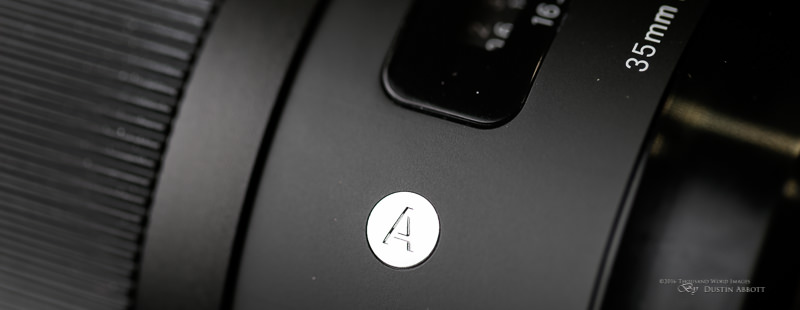
I recognize that I'1000 a petty late to the party in reviewing the Sigma 35mm f/1.4 DG HSM ART lens. It has been on the market for more than 3 years, and has gotten both writer's ink and photographer's dollars like no Sigma lens before it. I had never reviewed the lens previously, only when the Canon EF 35mm f/ane.4L II USM was released I knew a lot of people would be interested in knowing how it compared to the current benchmark in the industry, and shockingly, that benchmark was not made by Canon, Nikon, or Zeiss; it was made by Sigma. But pause for a moment and consider merely how incomprehensible that would have been four or 5 years ago. Iv years ago almost professionals sneered at the notion of owning a Sigma over a offset party lens, despite the release of a fairly practiced EX 50mm f/1.4 and a very expert EX 85mm f/i.4. But Sigma (along with Tamron) was still stuck in a 3rd party/3rd world mentality, namely, that their niche was to offer budget alternatives to first party lenses that undercut them in toll, offered competitive optical operation, only were usually inferior in build and autofocus performance. Then Sigma shocked the photography globe at the end of 2012 past introducing this beautiful new lens that looked nothing similar a Sigma. The Sigma 35mm f/1.4 DG HSM ART lens launched Sigma's rebranding/coming out party with their Global Vision initiative.
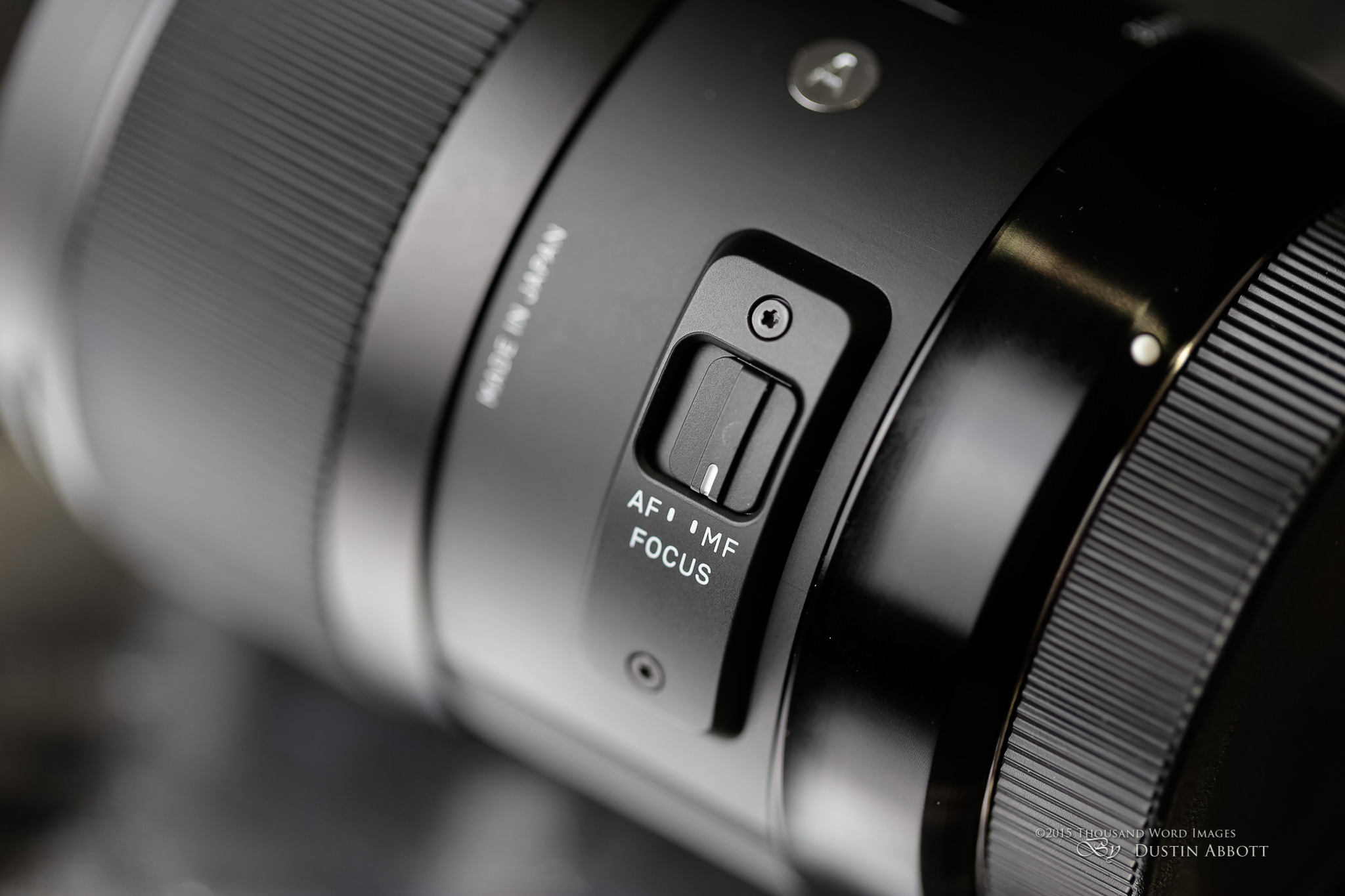
Part of this was a completely new branding system for their diverse products. Sigma abandoned the EX designation and instead introduced a three-pronged arroyo of "Art", "Contemporary", and "Sport" lines. A few of these categories are admittedly vague (what exactly makes a lens "Contemporary"?), but at that place is no arguing with the direction the design team has taken with the lenses designated "Art". Sigma not but dramatically improved upon their older design (which frankly I was non a huge fan of), but have designed some of the best looking modern lenses, menstruation. I've reviewed the 50mm, 18-35mm, 24-35mm, and at present this lens from the ART designation, along with the 150-600mm in both "Sport" and "Contemporary" variants, so the new Sigma wait is non quite and then new any longer, but I yet favor information technology over most all other lens designs.

I decided to go ahead and do a review of the Sigma 35mm f/i.4 Art (35A for short henceforth) that took into account the new releases from Canon and Tamron. Sigma is no longer the de facto choice, but do these new options make information technology whatsoever less deserving of your consideration?
Build Quality and Design
There is a very pleasing blend of glossy, matte, and ribbed surfaces that has both a mod yet elegant design. The "flocked" end is a thing of the past (good riddance, I say), as is the gilt ring that seems almost garish at present when presented with this sleek, understated new design. Yes, the lens is substantially all blackness with some small white print in a few points, but the blend of textures keeps the lens from being monochromatic or boring. The lens has small white text on one side that says, "Fabricated in Japan", an understated SIGMA make on the top, and then the lens designation and filter thread size near the distance window of the height of the barrel. Less obvious is a very small sized series number in a greyness text that is only obvious under close test. An elegant little silver circumvolve with the letter A (for ART) rests next the focus distance window. On the bottom of the butt is an 0xx number which conspicuously and plainly states the year of manufacture (bravo for simplicity!)
The lens has four singled-out bevels that flow into a wider section equally you motility towards the front chemical element. The get-go bevel flares from the lens mountain section into the area of the distance window and the single switch that controls focus (Machine/Manual). The HSM (Hypersonic Motor) allows for full time transmission override. The side by side bevel moves into the slightly wider focus ring. It has a nicely ribbed, slightly rubberized texture. The movement isn't every bit smooth equally, say, Tamron's new 35mm f/1.viii VC lens. I find the damping a little on the heavy/stiff side, but on the plus side information technology doesn't experience "gritty" at all. Manually focusing the lens is besides limited by a very short "throw" altitude, especially between nigh 6 feet and infinity. Making a fine manual adjustment is hard in that range due to the very pocket-sized focus throw of simply about 90 degrees (the Tamron 35 VC has nearly double that!). The final flare is to the front end of the lens where the lens hood bayonet attaches with a soft touch material transition to the hood that still impresses me when I encounter information technology fifty-fifty after seeing it on v or so other lenses. This is a very classy approach to lens design that borrows a page from Zeiss more than whatever other design.
If at that place is a shortcoming here it is that the lens does not take any kind of atmospheric condition sealing. In that sense the dazzler is only "skin deep". At the time that this lens was released, that wasn't actually a big deal, every bit the chief competitors from Canon (35L) and Nikon (35mm f/1.4G) also lacked any kind of weather sealing. But that has changed with recent releases, and while the Canon 35L II is twice the price of the Sigma (and is thoroughly weather sealed), the Tamron 35mm f/1.8 VC is non only nicely weather condition sealed only also undercuts the Sigma'due south price past $300 (at least in the US market).
While it is not surprising that this lens lacks weather sealing, I am surprised that all new subsequent Fine art series releases (including the very new 20mm f/1.iv Art) continue to lack it. Sigma seems to be reserving this for their telephoto lenses at the moment. Tamron has seized this as means of differentiating its new SP series of primes, and if that line enjoys success one wonders if Sigma volition persist in non adding weather sealing to the design of futurity ART series lenses.
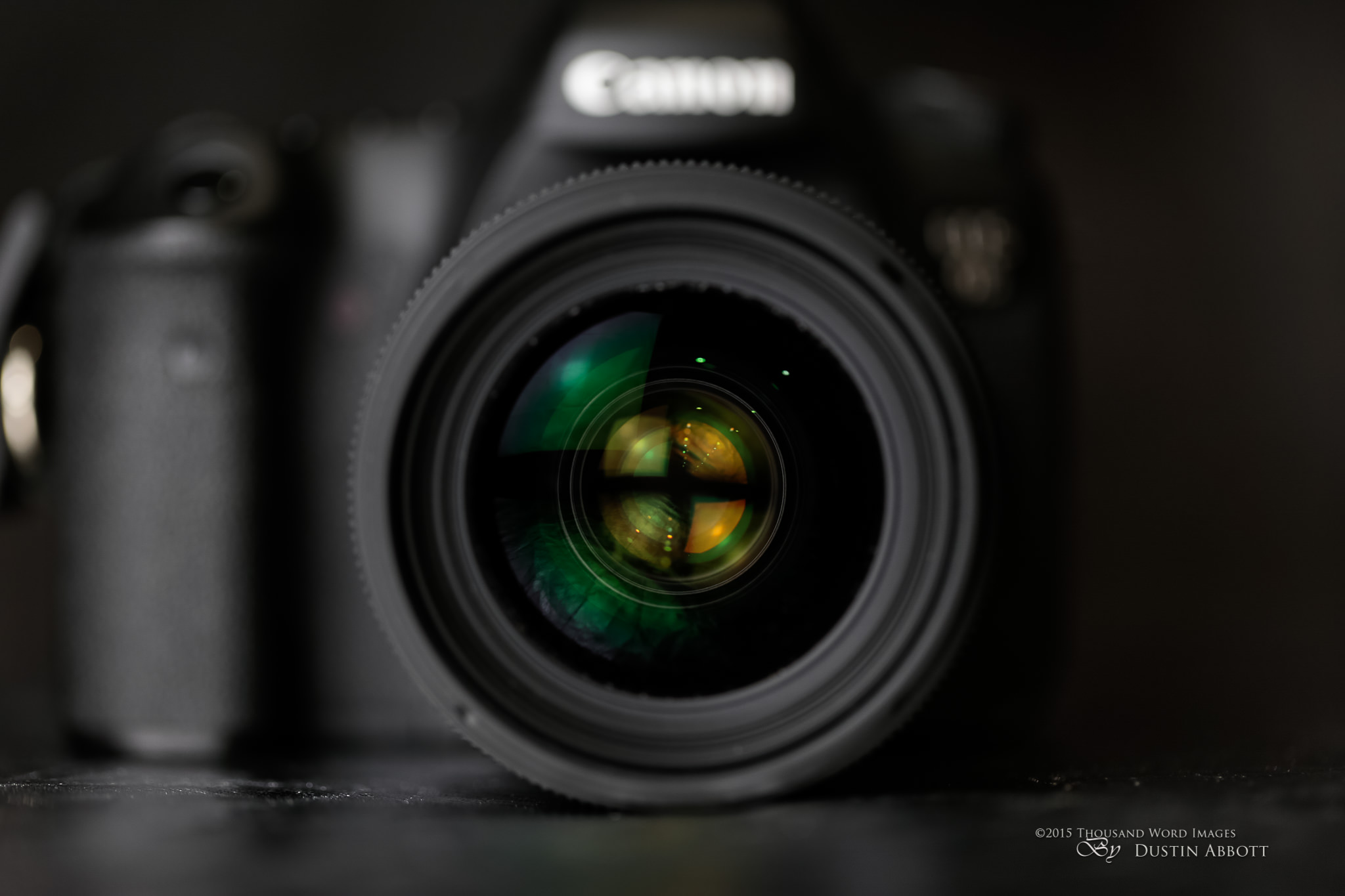
This lens got a lot of publicity due to having (at the time) class leading resolution and a beautiful lens design. A great price didn't hurt. It was introduced at $899 while the Canon 35L was closer to $1500 and Nikon 35G even more. Information technology's release managed to completely overshadow the release of Canon's splendid EF 35mm f/two IS, a lens that was speedily relegated to existence one of Canon's "underrated gems". I actually chose that lens over the Sigma back then, and information technology has served me well for years, only it seems similar just now is it starting to receive recognition for beingness a stellar lens. The larger aperture, beautiful design, and amazing resolution of the Sigma caught the attending of the public. All of a sudden it was entirely acceptable for professionals and amateurs alike to own a Sigma, and the success of the 35A (Sigma 35mm f/ane.4 Fine art) helped launch a whole series of lenses in the ART line since.
Merely it is now 2016, and Sigma faces pressure from an excellent lens beneath it in price (the Tamron), and a new form leader to a higher place it (the 35L II). The debate about the claim of the original 35L vs. the Sigma 35A went back and along, only there were a number of points that could non disputed: the Sigma was much, much sharper at wide apertures and had far less chromatic aberrations. The 35L might have a ameliorate drawing (global expect to the images), but that is something that doesn't prove up on a exam nautical chart, and in every "chartable" category the Sigma was coming out on tiptop.
But Canon has finally struck back, and the Canon EF 35mm f/1.4L 2 USM manages to raise the bar once again in almost every category…but it is too twice as much money. Here'south a look at the raw numbers:
| Lens | Sigma 35mm f/1.4 ART | Canon 35mm f/1.4L Ii | Canon 35mm f/2 IS | Tamron 35mm f/1.8 VC |
| Toll (at time of review) | $899 | $1799 | $549 | $599 |
| Overall Length | 94mm | 105.5mm | 62.6mm | 81.3mm |
| Overall Weight | 665g | 760g | 335g | 479g |
| Front Filter Thread | 67mm | 72mm | 67mm | 67mm |
| Elements/Groups | xiii/11 | 14/eleven | 10/eight | 10/ix |
| Min Focus/Max Mag | 30cm/.20x | 28cm/.21x | 24cm/.24x | 20cm/.40x |
| Aperture Blades | 9 | ix | 8 | ix |
At that place is one figure here where Sigma lags behind several competitors that I volition note, and that is in minimum focus distance/maximum magnification. This has been and continues to be an area of forcefulness for the 35mm focal length. 85mm lenses typically have very poor figures hither (a maximum magnification figure of .11-.13x is mutual), and even 50mm lenses (where the standard used to be around .15x), but 35mm lenses have always bettered those figures. The Sigma's power to focus downward to one foot/30cm and have a .20x magnification (i/5th life size) is useful, but not well-nigh as useful as the Canon 35 IS at .24x and is doubled by the Tamron'southward .40x figure (ane of the greatest strengths of that lens!).
The Sigma was a big lens upon its release, but in that location has been a trend towards larger and heavier lenses since its release, and so the new Catechism 35L Two adds virtually 100g of weight and ten.5mm of length. This comparison shows that information technology certainly exceeds the dimensions of the Sigma in every regard.
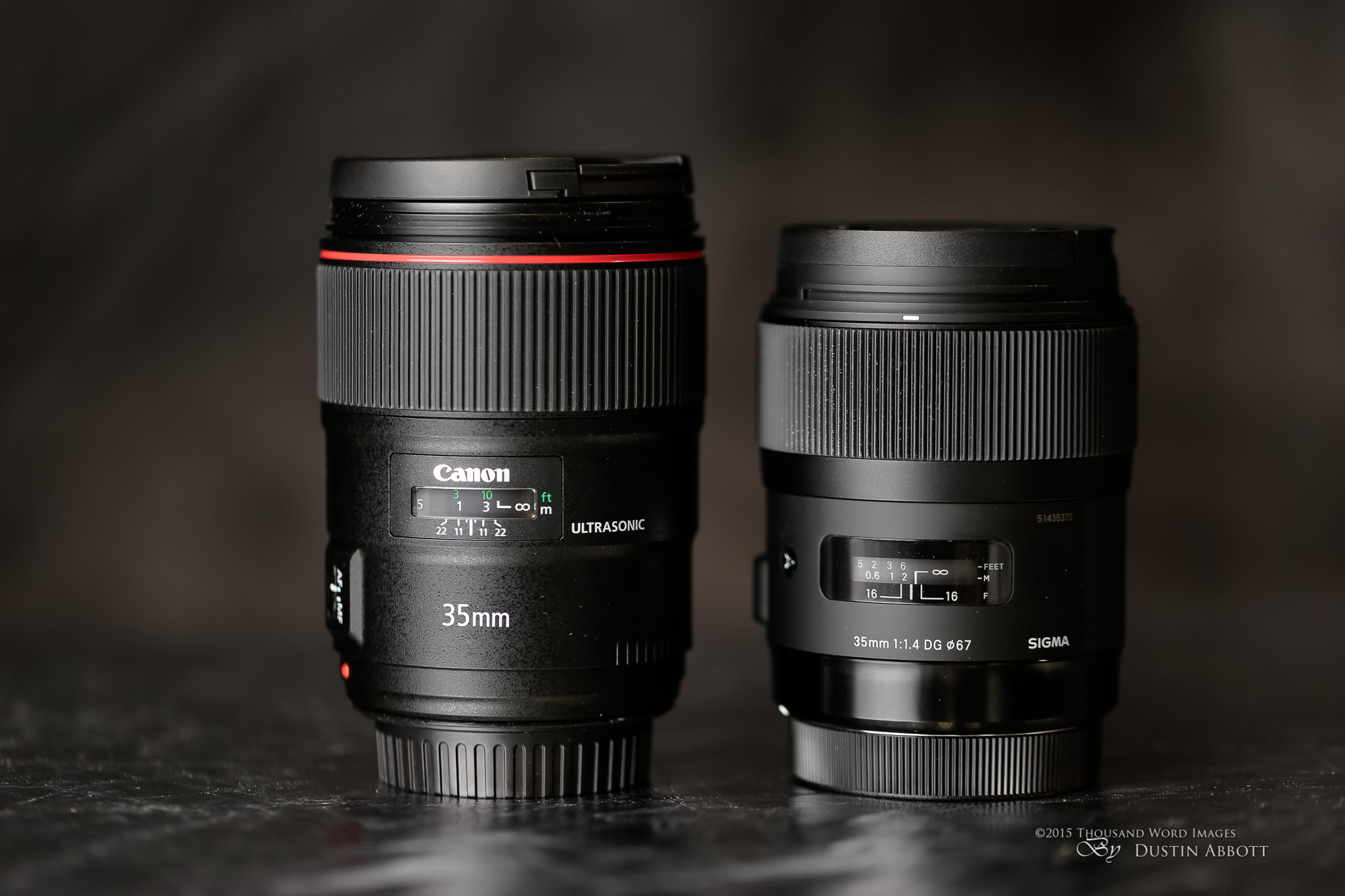
Across that, however, the Sigma ART line has likewise seen a number of larger releases (most notably the 50mm f/1.4 and the 24-35 f/2), so the 35A is at present only middle of the pack in size. It is a dense feeling lens, and is largish, but probably not and then much that information technology will evidence an impediment. Notwithstanding, if depression weight and minor size are a priority to you, I would recommend looking at the Catechism 35mm f/two IS (Canon shooters) or the Tamron 35mm f/i.eight VC (Catechism, Nikon, or Sony shooters) as those lenses offering competitive image quality and image stabilization, though at the price of a somewhat smaller aperture (just one that is still plenty wide for nearly applications).
I always commend Sigma for the inclusion of a squeamish, padded instance that offers existent protection for the lens. It is much more useful than the drawstring pouch that Canon throws in with their Fifty serial lenses. I wish others would take a cue from Sigma in this nice extra impact.
Autofocus

My first human activity when receiving whatsoever new autofocus lens is to spend some extended time calibrating the lens to the trunk/bodies I intend to utilize it on. For this purpose I use the FoCal 2 program from Reikan. My typical process is to run the automatic calibration at least 3 times (I'thousand looking for a repeatable consequence) and I then follow up with a semi-automated calibration where I have a closer await at the figure or figures that the automated scale produced. I will check results to either side of these figures to come across if there is a better 1. This allows me to both eyeball the bodily focus results and ensure that I have the most consequent focus setting.
I calibrated both the Sigma and the Canon 35L 2 on the aforementioned day, and eventually settled on a -2 for the Sigma and a +ii for the Canon. I had a piddling more variability in hunting down the Sigma value, simply was confident with the figure I produced. Throughout the flow of my review I used the lenses in a variety of settings, from general purpose shooting to events (church, school, and family) forth with some portraits. While impossible to encompass every type of shooting situation in a 4-five week catamenia, I experience that I used the lenses in enough of a diverseness of settings to be confident in my findings.
One of those events was at my children'southward school. It was a "Duct Tape Manner Show". The 7thursday and 8th grade classes had fashioned various costumes and article of clothing items out of duct record and paraded them up and downwardly the "runway" in the gym. I used both lenses dorsum and forth on the same camera body (the body they were calibrated to). I primarily shot in AF Servo mode, as the kids were always moving and rarely stopped long even when they were posing. As the official photographer for the outcome I was ready up right at the finish of the "runway" and kids came in from the far end of the gym, up the center aisle to me, so split up to either side, quickly posed, and and so retreated back the fashion they came. I shot 57 frames on the Sigma and 113 on the new Canon – all wide open up at f/1.iv. I used the lenses identically when shooting with the intent that I would compare frames at the finish of the shoot and make up one's mind which lens had the higher hit rate.
I went through and counted 9 improperly focused shots from the Canon (out of 113), for a striking rate of around 92%. Almost of these misses were with the subjects right on top of me and weren't in situations where I would have expected to get good results. In that location were about 2-three obvious misses where I would have expected accurate focus to be possible. This raises the keeper rate to better than 98% – very proficient nether the circumstances I was shooting in.
The Sigma was another story altogether. I counted at least xv missed focus shots, including almost all of those beyond 20 anxiety (all of which back focused across the main subjects). Here'due south a instance in point:

Reviewing the data in Lightroom via a plugin chosen "Show Focus Points" tells me that I was using AF Servo focus and that focus was locked with the center betoken square in the centre boy's face up…and yet the lens is actually focused on the far wall. Past contrast the Canon 35L II shots in the same state of affairs were all accurately focused.
My hitting rate was highest when the subjects were in the range of v-ten anxiety (the lens was calibrated at the recommended half-dozen-foot distance). The keeper rate with the Sigma dropped to under 64%. If yous intend to shoot events, sports, or photojournalism, the Catechism proved the much more reliable choice in this scenario…and that might be worth the premium price in and of itself. If you demand to shoot this mode and can't afford the 35L 2, I might recommend considering the 35mm f/2 IS instead. It has a slower discontinuity, yes, only it has an image stabilizer and similar full ring USM focus that is extremely fast and accurate. I've used it for a couple of years and it has proven one of my most accurately focusing lenses.
Purchasing Sigma's USB dock is ane means of helping with this, as it allows you to calibrate focus at various distances, while the photographic camera's AFMA office simply allows y'all to calibrate at i focus altitude (the altitude I calibrated at is the recommended distance). The dock as well allows you to upload firmware updates to the lens that should, theoretically, help to eliminate future incompatibility problems should the photographic camera manufacturer brand some change to the autofocus process. This is 1 distinct advantage for Sigma lenses, though reports from a variety of subscribers indicate that it doesn't ever solve the autofocus issues. This has been, in my feel, the Achilles' heel of Sigma's Art serial. Some photographers are very satisfied with the autofocus performance; others accept given upwardly on the lens in frustration. I observe myself typically somewhere in the middle. I've had mixed results with a broad department of Sigma lenses, with just one bad experience (the copy I had of the 18-35 f/one.8 Fine art was quite inconsistent) but generally fairly proficient results overall with occasional, inexplicable misses. Take, for example, this shot of a lingering oak leaf in the wintertime. The shot was stopped down to f/three.v, which gives the AF system more depth of field to piece of work with, and so I would not have expected this shot to have missed. I've included a screenshot from the software plugin for Lightroom called "Show Focus Points" that I use, and it shows from the EXIF data that the lens/photographic camera indicated focus lock (eye focus signal) and yet the photo (look at the ingather) is clearly non really in focus at all.
In many (even most) cases I got well focused results, only the misses were more frequent than what I'k accustomed to. At wide apertures I would sometimes observe that the focus was adequate but non really nailed, either, if I examined the image at a pixel level. I've been spoiled by the focus accuracy of the Catechism 35 f/2 IS, and both the Tamron 35mm f/1.eight VC and the Canon EF 35mm f/1.4L II performed very well for me while reviewing them. This video breaks down autofocus amongst the principal competitors in item, and volition give you a proficient idea of how the lens performed overall.
Thus far I accept not establish whatsoever third party lens that focuses quite as fast equally the best Canon USM lenses. Large aperture primes accept to move a lot of glass, and I detect that Canon not only does the best job of producing speed just also the best task of masking how much try is involved in speedily moving those elements. Sometimes with Tamron and Sigma lenses I observe that major focus shifts involve a sound and sense of "sliding" every bit the elements move into place. That sensation is much more than muted with the Canon 35L Ii. The Sigma is fast, for the well-nigh part, but there is a picayune pause while inertia builds when going from minimum distance focus back out to infinity accompanied by a slight "shhhhtck" sound as the elements slide into identify.
It's interesting to me the very different approach that Sigma and Tamron accept taken with dealing the challenge of focus with large discontinuity primes. The Sigma 35mm f/one.4 Art has a large aperture and quite fast focus but at the expense of having a very minor focus throw. It barely has 90 degrees of focus throw, and the distance betwixt 6 feet and infinity is TINY on the focus ring. It makes transmission focus very difficult and even makes me wonder if this doesn't contribute to the lens' somewhat poor focus accuracy in that range.
The Tamron SP 35mm f/1.viii VC takes a different road. Commencement, it has a somewhat smaller aperture (and thus a niggling less glass to motion), but it adds a much bigger focus range with a good 180 degrees of focus throw (basically double that of the Sigma). The Tamron takes a perception hit in its overall focus speed (which is just a tiny fleck slower), but the trade off is that you tin can both manually focus and autofocus with a bit more precision. This is even more pronounced in the 45mm VC vs. the Sigma 50mm f/1.four Fine art. Which arroyo is better? The respond will probably change from photographer to photographer.
If yous lean towards shooting more video than stills, the Tamron is a good choice as it has the all-time manual focus ring (past a good measure), longer focus throw, and adds an effective image stabilizer to the mix.
Some people find that the Sigma 35A works just fine for them; others have given upward despite its impressive optical performance. I have at present spent fourth dimension with the 35A, 50A, xviii-35A, and 24-35A lenses, and my ain experience has been a mixed bag. The 24-35A performed the best for me overall, and the 50A did well in spurts, simply my own decision is that autofocus accuracy continues to be Sigma'due south Achilles heel. I strongly want them to solve this issue as they really are designing lenses with very impressive optics.
In conclusion, if yous are a professional and need the all-time, most accurately focusing 35mm lens, the Canon 35L Ii is the new superlative selection; the Sigma isn't even close.
Image Quality

This has been and continues to be the area where the Sigma punches far above its price point. Information technology is the reason why this lens is now in so many photographer's kit; information technology delivers in the resolution/image quality department. In the past it was common for wide discontinuity primes to exist a bit "dreamy" broad open. This was frequently caused by both a lack of contrast at wide apertures along with chromatic aberrations that would rob the lens of apparent sharpness and brand images wait somewhat hazy in the details. This isn't the example with the Sigma 35A; it delivers at all apertures. Not only that, just while some primes are abrupt in the centre merely get increasingly soft every bit yous head out across the frame, the Sigma does a stellar chore of extending that sharpness beyond about all of the frame.
While I recognize that lenses similar this are going to be used at a diversity of apertures by terminate users, I tend to examination lenses like this primarily at apertures wider than f/2.8. The reason beingness that it is in this zone where prime lenses actually need to show their worth. The reality is that a number of modernistic zoom lenses are already excellent at their wide open f/ii.8 aperture, so a modern prime actually needs to polish at even wider apertures to justify its existence. The Sigma 35A certainly does.
Even at f/i.4 images expect crisp and sharp, providing a peachy "popular" of subjects from backgrounds. Even landscape type images wait quite skilful at f/i.4. Resolution is crisp, contrast is potent, and image quality is generally excellent. Check out this landscape shot at f/1.4 and the crops from across the frame:

This was unprecedented resolution from a 35mm f/1.4 lens, and it is but now that this functioning has been surpassed. The new Canon 35L Ii gets the edge in overall resolution, and I too didn't feel that the Sigma produced the aforementioned degree of microcontrast as the Canon. What I mean past this is that when zoomed into a pixel level at that place is a higher amount of contrast and less chromatic aberrations in the details of the Canon's images which results in the advent of higher resolution. At f/1.4 the Catechism is definitely resolving higher, and, as a effect, the lens is just that much more special. I also experience like the Canon is transitioning to defocus more nicely. It's rendering is more "magical". Information technology is also, of class, twice as expensive.

With either lens I was reminded of how much I bask the 35mm focal length as a walkabout lens. It seems to be "just right" for a number of things, and whether in the wood or on the city street the 35mm focal length seems broad enough for near everything without adding distortion. It is the "Goldilocks" focal length: not too close; non too far. For that thing, I also prefer the versatility of a broad aperture to that of a moderate zoom range. The ability to shoot well-nigh annihilation at f/1.4 (if y'all want that narrow a depth of field) gives you a lot of flexibility as to how you choose to frame a scene. In some instances, a shot of a scene with a narrow depth of field is interesting where it might just be busy with more depth of field. It's nine bladed aperture also makes for overnice sunstars/sunbursts when stopped down.
I used the lens equally a part of documenting our Christmas celebration this year, and after sharing the images one of my sisters-in-law remarked that I e'er make everything look so "sparkly". A large part of what she is referring to is that special 3D quality that loftier quality optics give to photographs. Wide discontinuity primes have the ability to make everything (even ordinary things) await simply a lilliputian bit more special!
Sigma did a good task of suppressing chromatic aberrations with the optical elements and coatings. While not nonexistent, the chromatic aberrations are well controlled and rarely objectionable in any mode. You will encounter a fiddling bit of green fringing in the out of focus area occasionally like this:

Canon has one time once more leapfrogged Sigma in this area, but I would say that the Canon advantage might exist seen more in the microcontrast than in dark-green or purple fringing in typical images. In this video segment I really break down resolution and overall image quality in particular:
Another strength of this lens is a near consummate lack of baloney. I really noticed how nicely this helped when shooting handheld exposures to exist combined in a panorama – everything lined up nicely. It makes information technology a very reasonable lens to shoot compages with, though 35mm isn't equally wide as one might similar.

The blazon of images that the Sigma is capable of is truly impressive. That incredibly sharp resolution on the subject field at wide apertures was and is revelatory. Y'all can view many more samples in the Sigma 35mm f/1.4 ART Image Gallery.
Optical Weaknesses?
The only real wing in the ointment optically is the very heavy vignette. It isn't uncommonly bad (the 35L Two is basically the same, although the new Tamron 35mm f/1.viii VC is far and away the winner in this surface area), just volition be noticeable in a broad variety of settings. This is pretty common for broad aperture primes used at broad apertures. In some cases a vignette produces a desirable event, but I would rather add together it in post rather than have to remove it. Add to this that you won't be able to load a contour to correct for this in JPEGs to your camera, though correction to RAW images is simple in mail service processing.
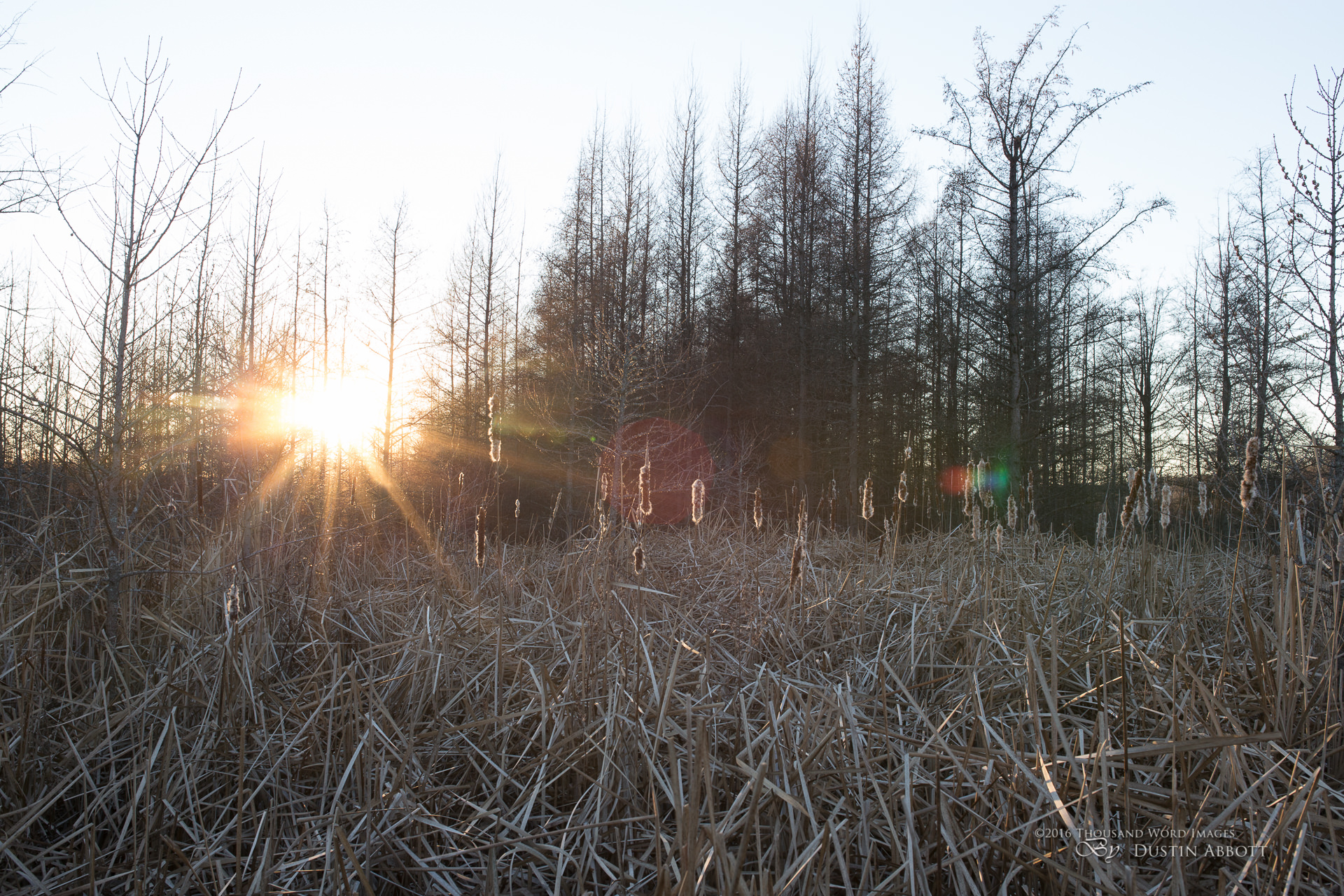
I was as well less than amazed at the flare resistance. I had a chance to shoot in highly directional lord's day while visiting the Mer Bleue conservation area in Ottawa, Ontario, Canada. This is one of the nearly studied bogs in the world, and provided some very unique shooting opportunities. The setting sunday was both intense and very directional; a perfect storm for testing flare resistance. Neither the Sigma 35mm f/1.4 ART nor the Catechism 35LII really impressed me; I've seen much better performance from both the Catechism 35mm f/2 IS along with the Tamron SP 35mm f/1.8 VC. Neither lens has equally broad an aperture, truthful, simply both are genuine competitors that performed better in this regard. The 35L Ii retained somewhat better contrast (the Sigma veiled a bit more), simply both showed a bit more ghosting artifacts than what I would like – and those can exist very difficult to remove in post. I don't heed a bit of veiling (it often creates a stylish effect), but ghosting artifacts can ruin an image. Here's a quick video segment showing flare resistance from the Sigma and its chief competitors.
Yet, as you can encounter, the listing of optical objections is pretty short when compared with the numerable strengths of the lens.
Bokeh Quality

Determining a lens' bokeh quality is somewhat challenging considering bokeh is both a subjective measure (the Helios 44-2 "swirly" bokeh is either wonderful or terrible depending on your perspective) and it is also notoriously difficult to demonstrate in a controlled test. Since its introduction there has been some argue about the bokeh quality from the Sigma. I myself accept referred to information technology as being somewhat "clinical", and feel that the lens tipped the scales more towards sharpness than overall drawing. The reality is that while the lens is perhaps not exceptional in this regard, it is in no way objectionable either. I've been using the lens side past side with the Canon 35L II over the past 5 weeks, and while I instinctively prefer the "await" of the images from the 35L Two, the reality is that the differences are subtle at most.
Bokeh is a matter of taste, simply one expanse where I tin can measure information technology is in how a lens handles bright out of focus specular highlights. I did a controlled test to compare the quality of the bokeh highlights. The subject area (an sometime 35mm f/3.five Super Takumar lens) was 17" from the sensor. The bokeh highlights (Christmas tree lights) were about seven feet beyond. I lit the foreground with a Metz 64 AF-1 flash through a Lite Genius Super-Scoop Ii and bounced off a wall behind the camera. I used mirror lockup, 2 2nd timer filibuster, Alive View 10x focus, and Rear Curtain sync to produce the smoothest calorie-free falloff issue. I determined that I best liked the expect of the image with a ¾ end underexposure by the photographic camera's meter. For what information technology is worth, the Sigma needed a fleck more than calorie-free co-ordinate to this metering method, so at that place is a minor variance in exposure values. I expect that DXOmark or others who measure out the lenses T-stop performance will find a shade better performance for the 35L Ii. The 35 f/2 IS, which I also used in this comparison, had a t-stop value equal to its f-stop (f/two), while the Sigma 35A clocked in at a t-stop of f/i.half-dozen, which is actually fairly decent compared to earlier generation competition.
When comparing the Sigma 35A and Canon 35L II side past side at a wide open up f/1.four discontinuity it is actually surprising how like the bokeh highlights looked. The shape of the highlights is roughly the same, and while there is but a hint of additional busyness in the Sigma'southward highlights, that is only detectable at ane:i pixel level. The Canon shows a slight scrap more than concentric rings while the Sigma shows more of a pattern. Every bit you move away from the center of the frame both lenses evidence a tendency towards lemon shapes instead of circles – a pretty common phenomenon. At identical exposure the Canon's paradigm is noticeable brighter, but probably no more than a quarter stop.
Stopping down to f/ii helps correct the lemon or cat-eye shape, merely besides further accentuates the signature of both lenses. The Sigma is bit more "patterned", and the concentric circles are slightly more than defined on the Canon. The Sigma does a slightly meliorate job of retaining circular shape, with the Canon showing the beginning hints of the shape of the discontinuity blades.
Trivial changes at f/ii.viii, although now both lenses prove the slight shape of their aperture blades at a 1:1 level to a similar degree.
Past f/four both lenses are producing highlights looking more than "nonagonal". The shape of the aperture blades is now clear, though the result is far less objectionable than the odd shape of the quondam 50mm f/1.8 and its five blades. At that place is besides far more calorie-free bleed around the edges of the shapes, but roughly at an equal level from both lenses. Ditto at f/v.half dozen, simply a stride further. Hither is a series from the Catechism from f/1.4 to f/five.6:
Here is the aforementioned series from the Sigma:
The Canon 35 f/2 IS has peradventure the smoothest bokeh of any of the 35mm options, just I don't see a major advantage in this kind of testing – and that bodes well for both these lenses. The bokeh highlights from 35IS look remarkably similar to those of the 35L II.
Here is the Catechism 35 IS series:
While I don't have the new Tamron SP 35mm f/1.8 VC on hand for this comparing, I did a similar test a few months agone and did add the Tamron SP 45mm f/ane.8 VC which I had on mitt to the examination every bit some other signal of comparison. Yous can see something similar in my review of the Tamron 35mm f/i.8 VC. The longer focal length of the Tamron 45 VC here means that the size of the bokeh highlights are larger, but the bokeh highlights are also noticeably busier than any of these other contenders. About Tamron lenses I have tested have shown a tendency towards the phenomenon often chosen "onion bokeh", though the 45VC too shows the reason why its bokeh looks so nice in most other situations – the inner line of the bokeh circle is nice and soft and thus produces bokeh without hard edges.
Both the Sigma and the Canon 35L Ii will produce less busy highlights than the Tamron 35 VC when bright low-cal sources are in the scene. Where the Tamron will win over all of these is in the corporeality of bokeh information technology can create in some situations due to being to focus much closer and having a maximum magnification figure twice that of Sigma (.40x).
Simply equally I said before, this exam really only shows bokeh quality in ane very specific style, and doesn't tell the whole story. I would encourage yous to judge the quality of the bokeh from any of these lenses based more on real life usage rather than any isolated test. Bokeh quality is ever a subjective thing, and most all of these lenses produce very good existent globe results…including the Sigma. Here is a little gallery with a few bokeh examples:
In Determination:
The merits of this lens are not going to be adamant past my conclusions. Over the past iii years this lens has received both critical and commercial success, and is, in my opinion, possibly the most important lens that Sigma has ever made. Sigma was able to completely redefine its position in the market based primarily on the forcefulness of this lens. It is telling that while nautical chart tests testify an advantage in resolution for the new Canon 35L II, that advantage is slight despite three additional years of development and a price point double that of the Sigma. The new Catechism's advantage in image quality is a matter of degrees, merely it certainly has a stronger reward in autofocus consistency. That remains the one surface area that might should give you pause when considering the Sigma 35mm f/1.iv DG HSM ART. At that place is trivial else to strongly criticize, and some accept reported having practiced autofocus success with their own re-create. As the saying goes, "Your Mileage May Vary". If your budget doesn't extend to the new Catechism 35L II, and you experience you need an f/i.4 aperture, then the Sigma remains the clear selection for quality optics at a reasonable price. I estimate some things haven't changed.
Pros:
- Prepare a new standard for optical performance at the 35mm focal that has only at present been mildly surpassed
- Beautiful and functional build
- Well controlled chromatic aberrations
- Low distortion
- High resolution even wide open
- Fast and placidity autofocus
- Includes nice padded case
- Excellent value to operation ratio
Cons:
- Autofocus performance can be inconsistent
- Adequately heavy vignette
- Flare resistance could be better
- Lacks conditions sealing
Alternatives:
The new Canon 35mm f/1.4L 2 USM is now the class leader for Canon shooters and surpasses the Sigma is nigh metrics. I reviewed it hither. It rings in at twice the price of the Sigma.
I reviewed the new Tamron SP 35mm f/1.8 VC a few months and was very impressed by it. Information technology has a somewhat smaller discontinuity value (f/one.8) merely offers upward a professional grade, weather sealed build quality, smashing optics, and adds an image stabilizer to the mix. Information technology likewise retails for three hundred dollars less.
The Sigma 24-35mm f/2 ART is also an interesting alternative. Information technology has a slower discontinuity merely delivers similar image quality forth with a minor zoom range. I reviewed it here. It retails for a hundred dollars more.
The Canon 35mm f/2 IS has a slower aperture simply has great focus, a wonderfully compact size, and a very effective image stabilizer. It is a bargain at $549. I reviewed it hither.
Review notes: I reviewed retail copies of both the Canon 35L II and Sigma 35A provided to me by the great people at B&H Photo .
Gear Used:
Canon EOS 6D DSLR Camera (Body Merely)
Sigma 35mm f/i.4 DG HSM ART Lens
Adobe Lightroom CC Software for Mac and Windows (Boxed Version)
Adobe Photoshop Creative Cloud 1-Twelvemonth Subscription
Alien Pare Exposure X (Use Code "dustinabbott" to go 10% annihilation and everything)
Purchasing your gear through B&H and these links helps fund this website and keeps the articles coming. Cheers for your back up.

Peachy News! I can now offer a 5% discount on all purchases at Amplis Foto, Canada'southward Leading Photographic Supplier. Delight enter discount lawmaking: AMPLIS52014 in your cart. It is good for everything in your cart, and is stackable with other coupons, too! Information technology volition take 5% off your unabridged order! Proceeds go towards keeping this site going and providing you with new reviews!
DISCLAIMER: This article and description contains chapter links, which means that if you click on ane of the product links, I'll receive a minor commission. Equally an Amazon Associate I earn from qualifying purchases.
Source: https://dustinabbott.net/2016/01/sigma-35mm-f1-4-dg-hsm-art-review/
0 Response to "Sigma 35mm F/14 Dg Hsm Art Review Sony"
Post a Comment